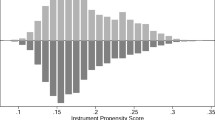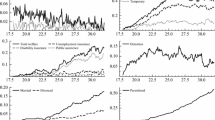Abstract
In this paper we look at the relationship between crime and economic incentives in a different way to other work in the economics of crime field. We look at empirical models where a toughening of the unemployment benefit regime can be used to study how people on the margins of crime may react to changes in economic incentives. We present three sets of complementary evidence, all of which show that toughening the benefit regime can have an unintended consequence, namely increases in crime. The first approach presents quasi-experimental evidence, looking at crime rates in areas of England and Wales before and after the introduction of a new, tougher unemployment benefit programme—the Jobseekers Allowance (JSA)—in October 1996. The second approach considers qualitative evidence on individuals affected by the change in the benefit regime. The third relates changes in area crime rates to post-JSA sanctions. Each of these approaches uncovers evidence of higher crime occurring as a consequence of the benefit reform.


Similar content being viewed by others
Notes
Classic economics of crime models also often discuss time allocation choices between legal activity and criminal activity of potential offenders. We concentrate here on the effect of changes in benefits and the toughness of the benefit regime but there is evidence (e.g. Grogger 1998; Fagan and Freeman 1999) showing that many crimes are committed by the employed.
We do not have good enough data to test this hypothesis but a large survey of unemployed claimants carried out pre and post-JSA introduction appears to find an important decrease in the take-home pay of males who left the claimant count into employment. The average weekly wage of men flowing out of unemployment in the year before the policy was introduced was £179 compared to £153 in the following year, corresponding to a reduction of 17% (see McKay et al. 1999).
We concentrate on the male population, accounting for three quarters of unemployed claimants and representing more than 90% of offenders sent to magistrate courts in England and Wales.
We are limited to this time period by the Labour Force Survey (LFS) socio-economic controls we make use of in our model. The geographical indicator which enables us to aggregate to our crime areas level is only included in the LFS from June 1995.
For example, Grogger (2000) presents a model of violent crime where economic incentives matter.
One could argue that exits to employment could still increase crime as it would provide indication of an area doing well economically and so increasing the potential earnings from crime. There is little research on this actually occurring but see, for example, Cantor and Land (1985) for some US evidence.
The proportion of claimants going to nowhere stood at 20.4% on the 4th quarter of 1995 and respectively at 18.3, 18.9, and 20.2% for the 1st, 2nd, and 3rd quarters of 1996.
We have not shown the equivalent figure for changes in violent crime, but it too shows a significant positive relationship (the estimated coefficient on changes in the outflow rate being .342 with an associated standard error of .166).
The focus is on 45 areas, incorporating the four London areas. However, results based on 41 police force areas using Home Office data proved similar (results available on request).
The estimated coefficients on these variables are not reported as our main concern is with changes in the outflow rate.
Or alternatively one can think of the estimates as difference-in-difference estimates of the change model (i.e. double-differenced in changes rather than triple-differenced in levels). As such they compare the relationship between changes in crime and changes in the outflow rate in the treatment period surrounding JSA introduction with the same relationship in the earlier (non-JSA) control periods.
Vincent’s (1998) report also highlights a general feeling of frustration or anger among the respondents. Whilst we would not want to make too much of this, work by psychologists in criminology (Dollard et al. 1939; Berkowitz 1989) does highlight that such feelings can act as a determinant of violent crime.
We are grateful to Sue Middleton from the CRSP at Loughborough University for giving us access to the original transcripts of the interviews.
Unfortunately we do not have access to the Metropolitan Police Crime Statistics System data for this time period and therefore have to look at the 41 area configuration as we are unable to disaggregate the London data.
References
Atkinson A, Micklewright J (1991) Unemployment compensation and labor market transitions: a critical review. J Econ Lit 29(4):1679–1727
Becker G (1968) Crime and punishment: an economic approach. J Polit Econ 76(2):175–209
Berkowitz L (1989) The frustration–aggression hypothesis: examination and reformulation. Psychol Bull 106(1):59–73
Cantor D, Land K (1985) Unemployment and crime rates in post World War II United States: a theoretical and empirical analysis. Am Sociol Rev 50(3):317–332
Card D (1992) Using regional variation in wages to measure the effects of the Federal minimum wage. Ind Labor Relat Rev 45(1):22–37
Dollard J, Doob L, Miller N, Mowrer O, Sears R (1939) Frustration and aggression. Yale University Press, New Haven
Ehrlich I (1973) Participation in illegitimate activities: a theoretical and empirical investigation. J Pol Econ 81(3):521–563
Ehrlich I (1996) Crime, punishment, and the market for offences. J Econ Perspect 10(1):43–67
Fagan J, Freeman R (1999) Crime and work. Crime and Justice: A Review Of Research 25:113–178
Freeman R (1999) The economics of crime. In: Ashenfelter O, Card D (eds) Handbook of labor economics 3C. Elsevier Science, Amsterdam, pp3529–3571
Gould D, Mustard D, Weinberg B (2002) Crime rates and local labor market opportunities in the United States: 1979–1997. Rev Econ Stat 84(1):45–61
Grogger J (1998) Market wages and youth crime. J Labor Econ 16(4):756–791
Grogger J (2000) An economic model of recent trends in violent crime. In: Blumstein A, Wallman J (eds) The crime drop in America. Cambridge University Press, Cambridge, pp 266–287
HMSO (1994) Jobseekers Allowance. Cm 2687:London
Machin S, Manning A, Rahman L (2003) Where the minimum wage bites hard: the introduction of the UK National Minimum Wage to a low wage sector. J Euro Econ Assoc 1(1):154–180
Machin S, Manning A (1999) The causes and consequences of long term unemployment in Europe. In: Ashenfelter O, Card D (eds) Handbook of labor economics 3C, Elsevier Science, Amsterdam, pp 3086–3139
Machin S, Meghir C (2004) Crime and economic incentives. J Human Res 39(4):958–979
McKay S, Smith A, Young R, Walker R (1999) Unemployment and jobseeking after the introduction of Jobseeker’s Allowance.DSS research report no. 99, Corporate Document Services, Leeds
Nagin D (1998) Criminal deterrence research: a review of the evidence and a research agenda for the outset of the twenty-first century. In: Michael T (ed) Crime and Justice: An Annual Review of Research 23:1–91
Elizabeth R, Shah S, White R, Dawes L, Tinsley K (2000) Evaluating Jobseeker’s Allowance: a summary of the research findings, Department of Social Security Research Report No. 116
Sweeney K (1998) The effect of Jobseeker’s allowance on the claimant count. Labour Mark Trends 4:195–203
Van Reenen J (2004) Active labor market policies and the British New Deal for the young unemployed in context. In: Card D, Blundell R, Freeman R (eds) Seeking a premier economy: the economic effects of British economic reforms, 1980–2000. National Bureau of Economic Research Chicago University Press, Chicago, pp 196–461
Vincent J (1998) Jobseeker’s Allowance evaluation: qualitative research on disallowed and sanctioned claimants. Phase two after Jobseeker’s Allowance. DfEE Research Report RR86
Acknowledgement
We would like to thank Gayll Thompson from the Department of Work and Pensions for their considerable help in getting us access to the sanctions data used in this paper. We would also like to thank Sami Berlinksi, Paul Gregg, Trevor Huddlestone, John Van Reenen, Joan Wilson and acknowledge comments from two anonymous referees, participants at the 2004 Royal Economic Society Conference, the 2004 Department of Work and Pensions Economics Group Conference at Royal Holloway, the 2005 SOLE/EALE Conference, a Centre for Economic Performance seminar at LSE and the Nordic conference on the Effects of Labour Market Policy and Education at Schäffergaarden.
Author information
Authors and Affiliations
Corresponding author
Appendix
Appendix
1.1 London crime data
Crime data for the five areas aggregating into the London Metropolitan Police Force were compiled from the “Metropolitan Police: Crime Statistics System (ME).” This database was provided by the University of London Computer Center (ULCC) who are in charge of the National Digital Archive Data (NDAD). The information contained relates to offences, clear-ups, arrests, victims of crime, property stolen and reports classified as “No Crime.” Each record includes details on the nature of the crime, the date at which it took place and various geographical indicators indicating where it was reported. We have attempted to match as precisely as possible this data to the quarterly property and violent crime statistics for the London Metropolitan Police Force of recorded crimes from the Home Office (HO).
The categorization of a crime into the property or violent category is dependent on the five digit Home Office Classification Code in each record. Property crimes consist of domestic burglaries (HO Codes 2800 to 2804, 2900 and 3000) and theft and handling of stolen goods (HO Codes 3700, 3702 to 3799, 3900 to 4999 and 5400 to 5499). Violent crimes comprise violence against the person (HO Codes 100 to 899, 1100 to 1599 and 3701) and robbery (HO Codes 3400 to 3499). The data is aggregated into five areas: Central (City of London, City of Westminster, Royal Borough of Kensington and Chelsea, and London Boroughs of Hammersmith and Fulham), North West (London Boroughs of Camden, Brent, Harrow, Barnet, Bexley, Ealing, Islington and Haringey), North East (London Boroughs of Waltham Forest, Redbridge, Enfield, Hackney, Tower Hamlets, Havering, Barking and Dagenham and Newham), South East (London Boroughs of Southwark, Lewisham, Bromley, Greenwich, Croydon and Sutton), and North West (London Boroughs of Richmond on Thames, Hounslow, Hillingdon, Wandsworth, Lambeth and Merton; Royal Borough of Kingston upon Thames). The date at which the crime was recorded by the police determines the quarter in which it is included.
When data from the five areas is aggregated to compare it to HO recorded crime numbers for the London Metropolitan Police Force this procedure does not yield perfect matches. The discrepancies are however marginal and some basic statistical analysis confirm that we can safely use the generated data. The correlation between our aggregated property crime data and the HO figures from the second quarter of 1995 to the fourth quarter of 1996 is highly reassuring at 0.999, and is 0.997 for violent crime. In terms of changes of in log(crime rates), the measure used as the dependent variable in our regressions, the correlations are 0.999 for property and 0.988 for violent crime.
About this article
Cite this article
Machin, S., Marie, O. Crime and benefit sanctions. Port. Econ. J. 5, 149–165 (2006). https://doi.org/10.1007/s10258-006-0010-9
Received:
Accepted:
Published:
Issue Date:
DOI: https://doi.org/10.1007/s10258-006-0010-9




